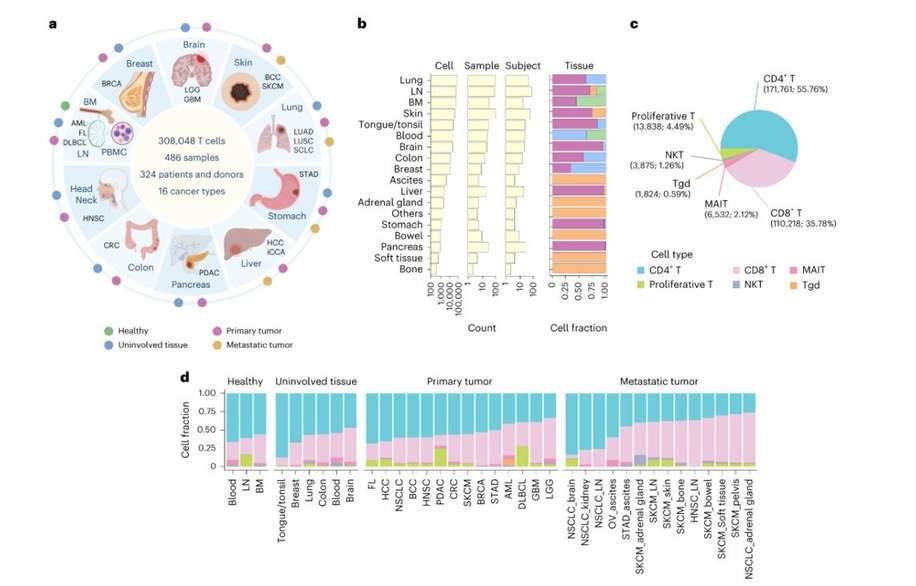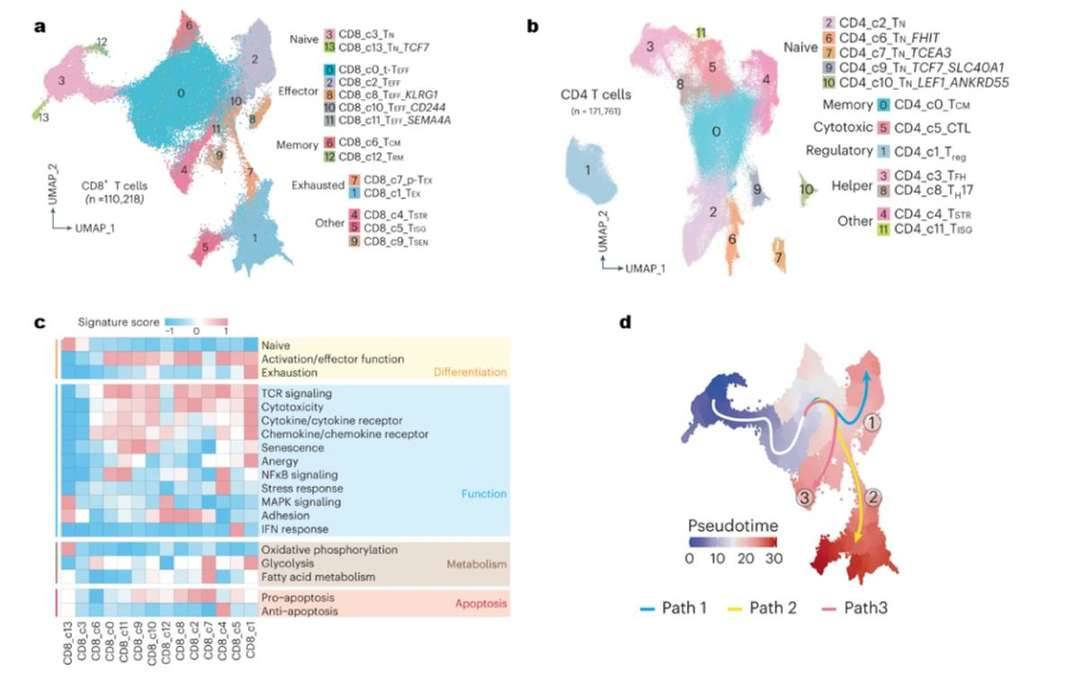Tumor-infiltrating T cells (TIL) are an important component of the tumor immune microenvironment (TIME) and show anticancer efficacy, such as chimeric antigen receptor (CAR) T cell therapies, TIL therapies and immune checkpoint blockade (ICB) therapies, providing a promising avenue for cancer treatment. TIL are extremely diverse in phenotype and function, and their phenotypic characteristics in the immune microenvironment and cellular composition determine the effectiveness and potential side effects of anticancer therapies. Given the remarkable heterogeneity of TILs and the rapid expansion of current T cell-based therapies or combination therapies into different cancer types, a comprehensive and in-depth analysis of TILs is warranted.
A Single-cell Atlas of T Cells
Recently, an article titled "Pan-cancer T cell atlas links a cellular stress response state to immunotherapy resistance" was published in Nature Medicine. The study constructed a single-cell atlas of T cells based on transcriptomic data from 308,048 tumor-infiltrating T cells from 16 cancer types, revealing previously undescribed heterogeneous subsets of T cell states, follicular helper T cells, regulatory and proliferative T cells, and identifying a unique stress response state, TSTR. characterized by heat shock gene expression.
The team analyzed T cells from 27 single-cell RNA sequencing datasets, including nine unique MD Anderson datasets, covering a total of 16 cancer types. The team mapped the new pan-cancer T-cell atlas, which is the most detailed characterization of T-cell heterogeneity present in TIME to date. The new pan-cancer T-cell atlas identifies a total of 32 distinct T-cell subpopulations, revealing how T-cell phenotypic states and the relative proportions of each play a key role in determining immunotherapy effectiveness and potential adverse effects.
 Pan-cancer analysis of T cells. (Chu et al., 2023)
Pan-cancer analysis of T cells. (Chu et al., 2023)
The study identified a previously undescribed T cell stress response state (TSTR), revealing a new way for tumor-infiltrating T cells to "go on strike". In previous single-cell studies, these T cells were often overlooked or considered to be artifacts associated with tissue isolation processes. However, based on the large amount of available data, researchers have now identified TSTR cells as a distinct population, clearly differentiated from other CD4 or CD8 T cell subsets, and their presence has been detected in situ by multiple spatial analysis methods in TIME from a variety of different cancer types.
The research team analyzed 375 patients from 23 cohorts, 171 of whom were treated with immune checkpoint inhibitors, for T cell status. The results showed that T-cell status/composition correlated with genomic, pathological and clinical characteristics in all patients. Notably, the proportion of TSTR cells among CD4 and CD8 T cells and heat shock gene expression were significantly increased and upregulated after immune checkpoint inhibitor treatment, especially in non-responding patients. These results suggest that TSTR cells may play a role in immunotherapy resistance. Taken together, this new T cell state deepens the understanding of the complex biology of cancer and provides a potential target for future therapies.
 T-cell fractionation and cell differentiation. (Chu et al., 2023)
T-cell fractionation and cell differentiation. (Chu et al., 2023)
The study provides a high-resolution T-cell atlas with well-defined cell states and genetic signatures. In total, the team characterized 32 T cell states and further identified seven subpopulations in the CD4 regulatory subpopulation, five subpopulations in the CD4 follicular helper T cell population, and eight states in the proliferating T cells. These findings underscore the broad heterogeneity of T cell states in the tumor microenvironment and the need to further understand how these states contribute to disease progression and immunotherapeutic response. The results of this study may help researchers to conduct in-depth analysis of T cells and facilitate the development of strategies that can enhance T cell therapy.
Reference:
-
Chu, Yanshuo, et al. "Pan-cancer T cell atlas links a cellular stress response state to immunotherapy resistance." Nature Medicine (2023): 1-13.
For research purposes only, not intended for clinical diagnosis, treatment, or individual health assessments.


 Sample Submission Guidelines
Sample Submission Guidelines
 Pan-cancer analysis of T cells. (Chu et al., 2023)
Pan-cancer analysis of T cells. (Chu et al., 2023) T-cell fractionation and cell differentiation. (Chu et al., 2023)
T-cell fractionation and cell differentiation. (Chu et al., 2023)